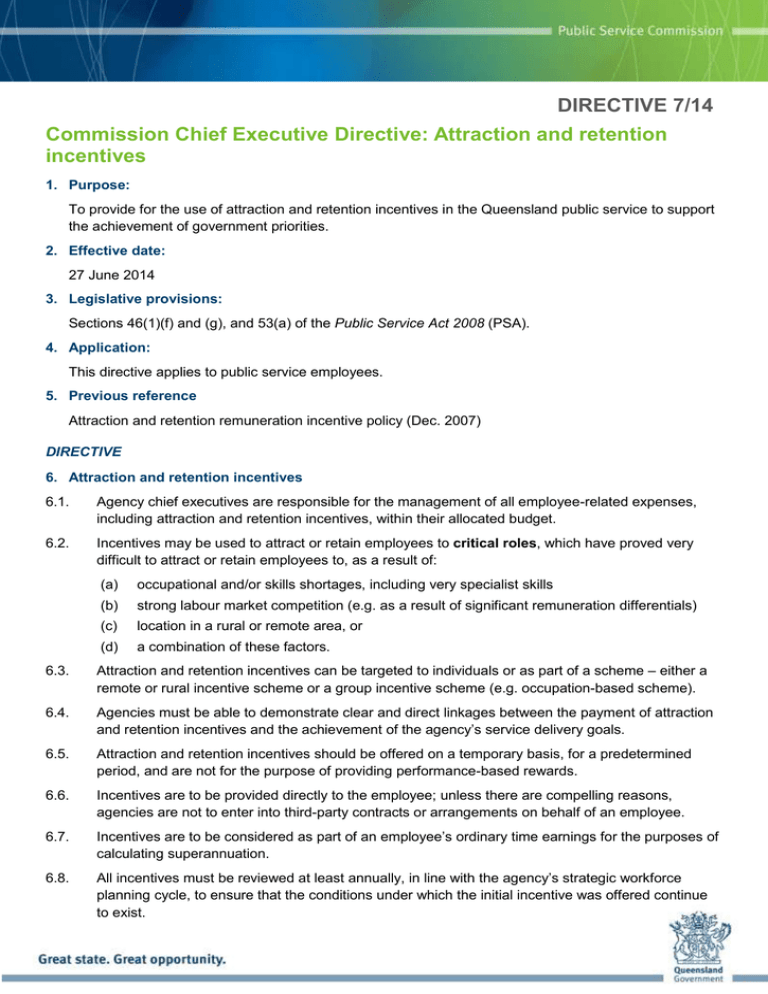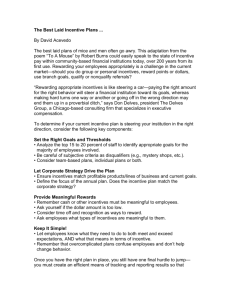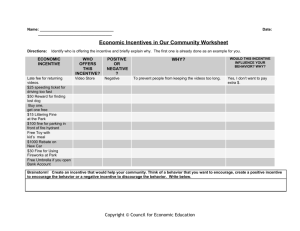Attraction and retention incentives
advertisement

DIRECTIVE 7/14 Commission Chief Executive Directive: Attraction and retention incentives 1. Purpose: To provide for the use of attraction and retention incentives in the Queensland public service to support the achievement of government priorities. 2. Effective date: 27 June 2014 3. Legislative provisions: Sections 46(1)(f) and (g), and 53(a) of the Public Service Act 2008 (PSA). 4. Application: This directive applies to public service employees. 5. Previous reference Attraction and retention remuneration incentive policy (Dec. 2007) DIRECTIVE 6. Attraction and retention incentives 6.1. Agency chief executives are responsible for the management of all employee-related expenses, including attraction and retention incentives, within their allocated budget. 6.2. Incentives may be used to attract or retain employees to critical roles, which have proved very difficult to attract or retain employees to, as a result of: (a) occupational and/or skills shortages, including very specialist skills (b) strong labour market competition (e.g. as a result of significant remuneration differentials) (c) location in a rural or remote area, or (d) a combination of these factors. 6.3. Attraction and retention incentives can be targeted to individuals or as part of a scheme – either a remote or rural incentive scheme or a group incentive scheme (e.g. occupation-based scheme). 6.4. Agencies must be able to demonstrate clear and direct linkages between the payment of attraction and retention incentives and the achievement of the agency’s service delivery goals. 6.5. Attraction and retention incentives should be offered on a temporary basis, for a predetermined period, and are not for the purpose of providing performance-based rewards. 6.6. Incentives are to be provided directly to the employee; unless there are compelling reasons, agencies are not to enter into third-party contracts or arrangements on behalf of an employee. 6.7. Incentives are to be considered as part of an employee’s ordinary time earnings for the purposes of calculating superannuation. 6.8. All incentives must be reviewed at least annually, in line with the agency’s strategic workforce planning cycle, to ensure that the conditions under which the initial incentive was offered continue to exist. 6.9. Payment of incentives must be reported in accordance with the requirements of the Financial Accountability Act 2009. 6.10. Agencies must maintain adequate records regarding the payment of all attraction and retention incentives. Types of incentives 7. Individual incentives 7.1. An agency may identify that the payment of a significant incentive to an individual is required to assist in ensuring the attraction or retention of an employee to a critical role. 7.2. A significant incentive may be offered and paid through an individual employment contract (e.g. s122 PSA contract) or through another mechanism (e.g. detailed letter of employment). 8. Group incentive schemes 8.1. Incentive schemes can be established to support the attraction and retention of a group of employees to critical roles. 8.2. Group incentive schemes may be required to support: (a) the attraction of a cohort of employees to critical roles, e.g. a program to attract people to a number of professional roles that have proved very difficult to attract or retain employees to (b) the retention of a critical cohort of employees where there is an identified business risk, e.g. to support the delivery of a priority project (c) the payment of incentives to a cohort of employees from another funding source, e.g. Commonwealth government. 9. Rural and remote incentive schemes 9.1. Agencies can establish (or continue) their own incentive schemes to support the attraction and retention of employees in rural and remote areas. 9.2. Rural and remote incentive schemes may provide financial or in-kind incentives to employees to attract or retain them to a particular location. 9.3. Rural and remote incentive schemes may incorporate a range of incentive options, including (but not limited to): (a) subsidised accommodation (b) concessional travel arrangements (c) education assistance for dependents (d) additional leave entitlements (e) additional learning and development entitlements (f) priority transfer following a period of service. 10. Approval for incentives 10.1. An agency must seek approval from the Commission Chief Executive (CCE), Public Service Commission (PSC) prior to offering a significant incentive to an employee or establishing a group incentive scheme. 10.2. A business case supporting the request must be submitted following consultation with the Executive Director, Workforce Strategy, PSC, and must: (a) outline the rationale for offering the incentive/s or incentive scheme, including detailing the way(s) in which the role/s has/have a clear and significant impact on government priorities and/or critical service delivery Page 2 of 4 10.3. (b) provide evidence outlining why the role/s is/are considered very difficult to attract or retain employees to, including (as appropriate) labour market assessment, supply issues, vacancy history, previous strategies undertaken to fill the role/s and associated outcomes (c) provide evidence of the evaluated classification of the role/s (d) detail the total cost of the proposed incentive/s or incentive scheme and the rationale for same (e) indicate the period of the incentive/s or incentive scheme, the necessary processes for payment and proposed schedule of review of the incentive/s or incentive scheme, and (f) identify whether other incentives are to be offered (including, where relevant, under a rural and remote incentive scheme). Where an additional significant incentive is thought to be required for an individual currently receiving an incentive under a group scheme or rural and remote scheme, further approval must be sought from the PSC through the business case process. 11. Payment of incentives 11.1. Agencies must ensure employees are aware of the temporary nature of the payment of incentives, to emphasise that incentives are only provided to meet circumstances which are subject to change. 11.2. The payment strategy of an incentive may depend on the specific circumstances under which the incentive is required, for example: (a) to support the retention of a critical employee, payments may be weighted towards the end of a predetermined period (b) to provide initial attraction and ongoing retention, payment of half of the agreed annual incentive at the commencement of the engagement, and payment of the remaining incentive half-way into the engagement, following a review to determine if agreed milestones have been met. 11.3. Agencies should liaise as soon as practicable with payroll providers regarding the payment plan of incentives. 11.4. Agencies are responsible for applying the correct tax treatment (including fringe benefits tax) to all incentive items provided. 11.5. Employees are responsible for seeking their own financial advice regarding the effects that an incentive may have on their tax liabilities etc. 11.6. Agencies may incorporate a repayment provision into an agreement to pay an incentive. (a) This may be particularly appropriate where an incentive has been offered to attract an employee to a role, and the employee leaves the role prior to its nominal end date. (b) The terms of repayment would need to be based on the specific circumstances of the agreement, including length of engagement, frequency of payments etc. 12. Review of incentives 12.1. All incentives and incentive schemes must be reviewed on the basis of whether the payment of an incentive is contributing to the achievement of the stated objectives, prior to further payments being provided. 12.2. Reviews must occur at least annually, but may be reviewed more often dependent on the terms and length of the arrangement. 12.3. Reviews must consider the following issues: (a) is the role still considered critical, and therefore the payment of an incentive still warranted, or have the agency’s priorities changed? Page 3 of 4 12.4. (b) do the original conditions regarding the difficulty of attracting/retaining employees, as identified in the business case, continue to apply? (c) if the incentive was to support retention, has this been effective or does the approach need to be reconsidered? If, through a review process, it is determined that an incentive is no longer warranted, an employee must be provided with reasonable notice prior to the withdrawal of the incentive. 13. Definitions Unless otherwise provided, the definitions contained in the PSA apply. Critical roles mean roles that: are very difficult to attract or retain employees to, e.g. multiple, traditional recruitment strategies will not yield a quality pool of candidates, and have a significant and immediate impact on government service delivery to the community, if left unfilled. Significant incentive means a cash payment/s that has a total value greater than ten per cent of the superannuable salary of the evaluated role classification. Page 4 of 4







